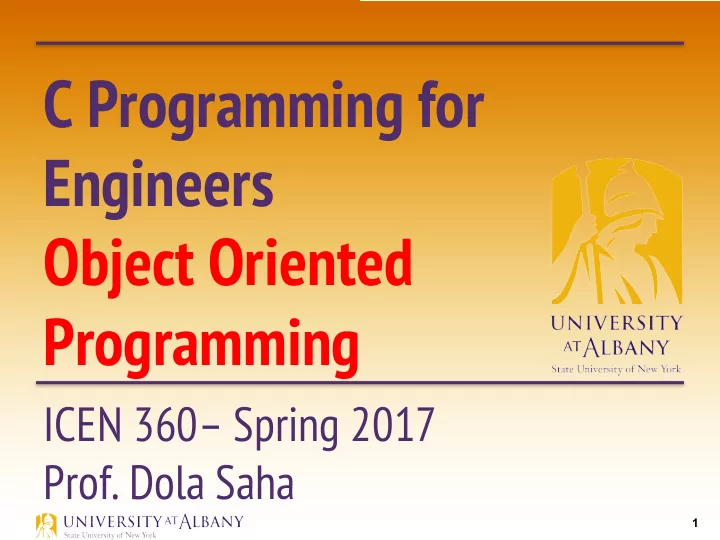

C Programming for Engineers Object Oriented Programming ICEN 360– Spring 2017 Prof. Dola Saha 1
Evolution of computers Ø Early computers were far less complex than today’s computers Ø Modern computers are smaller, but more complex 2
Objects Ø Computer scientists have introduced the notion of objects and object-oriented programming to help manage the growing complexity of modern computers. Ø Object is anything that can be represented by data in computer’s memory 3
Properties Ø The data that represent the object are organized into a set of properties . Name : PA 3794 Owner : US Airlines Ø The values stored in an Location : 39 52′ 06″ N 75 13′ 52″ W object’s properties at any Heading : 271° one time form the state of Altitude : 19 m an object. AirSpeed : 0 Make : Boeing Model : 737 Weight : 32,820 kg 4
Methods Ø In object-oriented programming, the programs that manipulate the properties of an object are the object’s methods . Ø We can think of an object as a collection of properties and the methods that are used to manipulate those properties. 5
Class Ø A class is a group of objects with the same properties and the same methods. Class <CAR> Object Object Object <7_series_BMW> <Ford_Mustang> <VW_Beetle> 6
Instance Ø Each copy of an object from a particular class is called an instance of the object. Ø The act of creating a new instance of an object is called instantiation. Ø Two different instances of the same class will have the same properties, but different values stored in those properties. 7
Terminology Object Property The same terminology is used Instantiation in most object-oriented Method programming languages. Class Instance State 8
First OOP in C++ 9
Access Specifier: Public & Private Ø Keyword public or private is an access specifier. Ø Access specifiers are always followed by a colon (:) Ø Public: Ø Accessible to public—that is, it can be called by other functions in the program (such as main), and by member functions / methods of other classes (if there are any). Ø Private: Ø Accessible only to member functions / methods of the class for which they are declared. 10
Passing value 11
Classroom Assignment Ø Extend the second OOP to § Call the method twice with two different messages § Instantiate two gradebooks and display different messages 12
Example object with properties & methods (1) 13
Example object with properties & methods (2) 14
Example object with properties & methods (3) 15
Constructor and Destructor Ø A constructor is a special function that gets called automatically when the object of a class is created. Ø A destructor is a special function that gets called automatically when an object is deleted. 16
Constructor Example 17
Constructor Example 18
Constructor Example 19
Separate Function definition & declaration 20
Separate Function definition & declaration 21
Separate Function definition & declaration 22
Recommend
More recommend